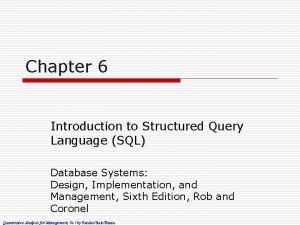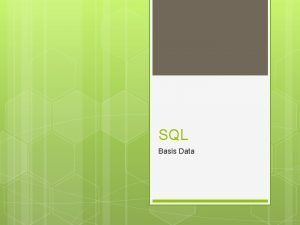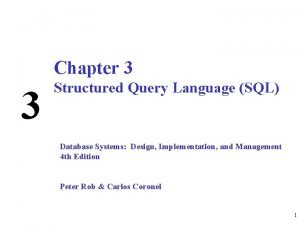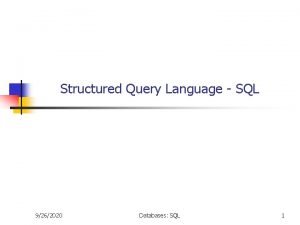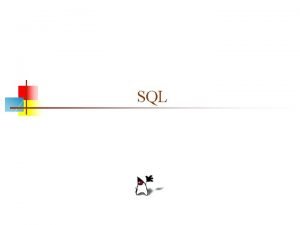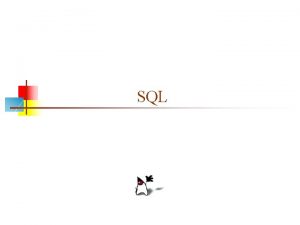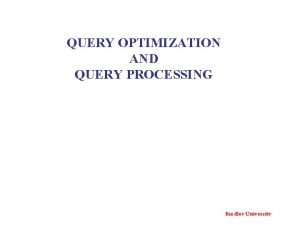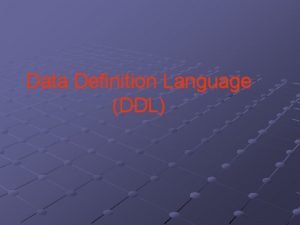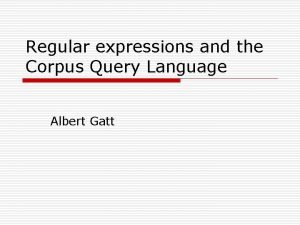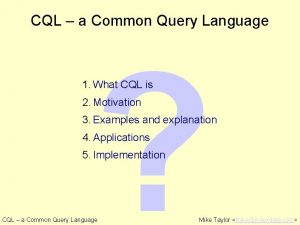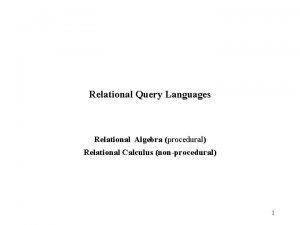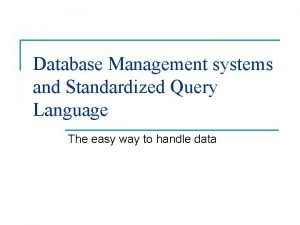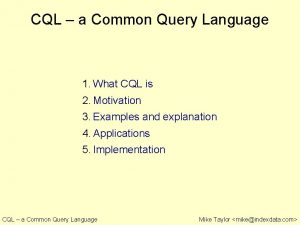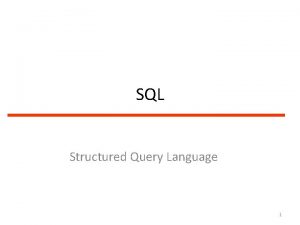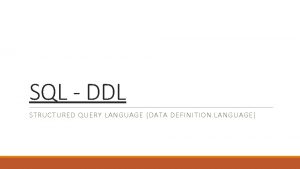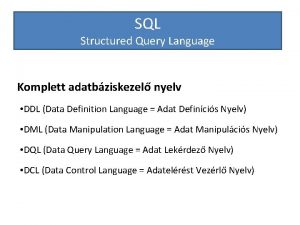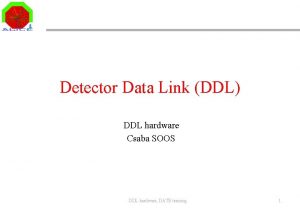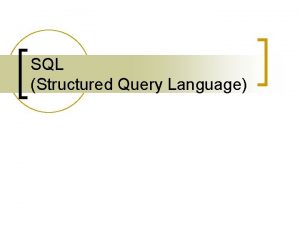Chapter 5 Part 1 DDL STRUCTURED QUERY LANGUAGE




























- Slides: 28

Chapter 5: Part 1: DDL STRUCTURED QUERY LANGUAGE (SQL)

Objectives 2 � The purpose and importance of SQL. � To understand the basic components of SQL. � Advantages of SQL � To be able to apply SQL command. How to use DDL in SQL How to use DML in SQL

Introduction to SQL 3 � � Ideally, database language should allow user to: create the database and relation structures; perform insertion, modification, deletion of data from relations; perform simple and complex queries. The language must perform these tasks with minimal user effort and command structure/syntax of the language must be easy to learn. � The language must be portable.

Introduction to SQL 4 What is SQL? � SQL stands for Structured Query Language � SQL lets you access and manipulate databases � SQL is an ANSI (American National Standards Institute) standard

Introduction to SQL 5 SQL: Structured Query Language that can: � SQL can execute queries against a database � SQL can retrieve data from a database � SQL can insert records in a database � SQL can update records in a database � SQL can delete records from a database � SQL can create new databases � SQL can create new tables in a database � SQL can create stored procedures in a database � SQL can create views in a database � SQL can set permissions on tables, procedures, and views

Introduction to SQL 6 Briefly, SQL can: create the database and relation structures; perform insertion, modification, deletion of data from relations; perform simple and complex queries.

Introduction to SQL 7 2 major components: 1. Data Definition Language (DDL) � defining database structure. � allows database objects such as schemas, domains, tables, views and indexes to be created and destroyed. 2. Data Manipulation Language (DML) � retrieving and updating data. � used to populate and query the tables. � data manipulation.

Introduction to SQL 8 2 major components: 1. Data Definition Language (DDL) The DDL part of SQL permits database tables to be created or deleted. It also define indexes (keys), specify links between tables, and impose constraints between tables. The most important DDL statements in SQL are: v CREATE DATABASE - creates a new database v ALTER DATABASE - modifies a database v CREATE TABLE - creates a new table v ALTER TABLE - modifies a table v DROP TABLE – removes a table from a database v CREATE INDEX - creates an index (search key) v DROP INDEX - removes an index

Introduction to SQL 9 2 major components: 2. Data Manipulation Language (DML) The query and update commands form the DML part of SQL: v SELECT - extracts data from a database v UPDATE - updates data in a database v DELETE - deletes data from a database v INSERT INTO - inserts new data into a database

Advantages of SQL 10 � Advantages of SQL are: 1. SQL is relatively easy to learn: � non-procedural - you specify what information you require, rather than how to get it; 2. Consists of standard English words: � CREATE TABLE book (ISBN VARCHAR(15), title VARCHAR(95), price DECIMAL(4, 2)); 3. Can be used by a range of users: � Database Administrator (DBA) � Management Personnel � Application Developers � Many others type of end-users

Writing SQL Commands 11 SQL statement consists of reserved words and user defined words. Reserved words are a fixed part of SQL and must be spelt exactly as required and can not be split across lines. User-defined words are made up by user and represent names of various database objects such as relations, columns, views.

Writing SQL Commands 12 Most components of an SQL statement are case insensitive, except for literal character data. More readable with indentation and lineation: Each clause should begin on a new line. Start of a clause should line up with start of other clauses. If clause has several parts, should each appear on a separate line and be indented under start of clause.

SQL Statement Example 13 CREATE TABLE customer (cust. NO last. NAME first. NAME address INTEGER PRIMARY KEY, VARCHAR(30), VARCHAR(30));

SQL Limitations 14 SQL is standard, BUT……. � Although SQL is an ANSI (American National Standards Institute) standard, there are many different versions of the SQL language. � However, to be compliant with the ANSI standard, they all support at least the major commands (such as SELECT, UPDATE, DELETE, INSERT, WHERE) in a similar manner. � Note: Most of the SQL database programs also have their own proprietary extensions in addition to the SQL standard! *Microsoft Access supports some but not all of the SQL specification!*

SQL Constraints 15 Constraints are used to limit the type of data that can go into a table. Constraints can be specified when � a table is created with the CREATE TABLE statement � or after the table is created with the ALTER TABLE statement

SQL Constraints 16 � NOT NULL � UNIQUE � uniquely identifies each record in a database table. Primary keys must contain unique values. A primary key column cannot contain NULL values. Each table should have a primary key, and each table can have only one primary key. FOREIGN KEY � uniquely identifies each record in a database table. UNIQUE and PRIMARY KEY constraints both provide a guarantee for uniqueness for a column or set of columns. A PRIMARY KEY constraint automatically has a UNIQUE constraint defined on it. you can have many UNIQUE constraints per table, but only one PRIMARY KEY constraint per table. PRIMARY KEY � enforces a column to NOT accept NULL values. A FOREIGN KEY in one table points to a PRIMARY KEY in another table DEFAULT used to insert a default value into a column.

Literals 17 All non-numeric literals must be enclosed in single quotes: � ‘New York’ � ‘London’ All numeric literals must not be enclosed in quotes: � 200 � 650. 00

18 DDL Data Definition Language Defining database structure/schema

Data Definition Languages (DDL) 19 DBMS creates tables using SQL commands Database administrator creates schema Logical group of tables or logical database Groups tables by owner Enforces security Relations and other database objects exist in an environment. Each environment contains one or more catalogs, and each catalog consists of set of schemas. Schema is named collection of related database objects. Objects in a schema can be tables, views, domains, assertions, collations, translations, and character sets. All have same owner.

Data Definition Language (DDL) 20 Data Definition SQL commands describe the database structure or schema: COMMAND/OPTIO DESCRIPTION N CRATE SCHEMA Creates a new database schema AUTHORIZATION CREATE TABLE Create a new table in the user’s database schema NOT NULL Constraints that ensures that a column doesn’t have a null value UNIQUE Constraints that ensures that a column doesn’t have a duplicate values ALTER TABLE Modify a table definition DROP TABLE 20

DDL: Data Type Data type are type of data that can be defined using SQL: Data Type Description integer(size) int(size) smallint(size) tinyint(size) Hold integers only. The maximum number of digits are specified in parenthesis. decimal(size, d) numeric(size, d) Hold numbers with fractions. The maximum number of digits are specified in "size". The maximum number of digits to the right of the decimal is specified in "d". char(size) Holds a fixed length string (can contain letters, numbers, and special characters). The fixed size is specified in parenthesis. varchar(size) Holds a variable length string (can contain letters, numbers, and special characters). The maximum size is specified in parenthesis. date(yyyymmdd) Holds a date 21

DDL: Create Table 22 This example demonstrates how you can specify primary key and a maximum length for some columns: Example: CREATE TABLE staff (staff. NO VARCHAR(10) NOT NULL PRIMARY KEY, staff. NAMEVARCHAR(25), city VARCHAR(25) DEFAULT “Jengka”); An empty table ‘staff’ is created with staff. NO as a primary key: and a default value for city attribute 22

DDL: Create Table 23 There a lots of ways that you can used to determine a PK of a table. Here are some of the examples: CREATE TABLE staff (staff. NO VARCHAR(10)PRIMARY KEY, staff. NAME VARCHAR(25), city VARCHAR(25)); CREATE TABLE staff (staff. NO VARCHAR(10)NOT NULL PRIMARY KEY, staff. NAME VARCHAR(25), city VARCHAR(25)); CREATE TABLE staff (staff. NO VARCHAR(10), staff. NAME VARCHAR(25), city VARCHAR(25), PRIMARY KEY(staff. NO)); 23

DDL: Create Table 24 Assume that you have table staff as stated below. CREATE TABLE staff (staff. NO VARCHAR(10)PRIMARY KEY, staff. NAME VARCHAR(25), city VARCHAR(25)); Then you want to create table printer that have relation with table staff. You can archive this task by defining Foreign Key. in table printer as shown: CREATE TABLE printer (printer. NO VARCHAR(10)NOT NULL PRIMARY KEY, description VARCHAR(25), mod VARCHAR(25), FOREIGN KEY (staff. NO) REFERENCES staff(staff. NO)); An empty table ‘printer’ is created with printer. NO as primary key printer. N desciptio mod staff. NO and staff. NO O n as a foreign key:

DDL: Create Table 25 You also can create table printer first. CREATE TABLE printer (printer. NO VARCHAR(10) NOT NULL PRIMARY KEY, description VARCHAR(25), mod VARCHAR(25)); Then create another table staffprinter that contain composite primary key by using staff. NO and printer. NO to make relationship between those two table as depicted below: CREATE TABLE staffprinter (staff. NO VARCHAR(10) NOT NULL REFERENCES staff, printer. NO VARCHAR(10) NOT NULL REFERENCES printer, qty INT, PRIMARY KEY (staff. No, printer. No)); An empty table ‘staffprinter’ is created with composite primary key (printer. NO and staff. NO)staff. NO printer. NO qty

DDL: Drop Table 26 DROP command will delete the table and its structure. v If use with RESTRICT: a table that contains Foreign Key will not be deleted v If use with CASCADE: all attributes will also be deleted DROP TABLE staff; DROP TABLE printer RESTRICT;

DDL: Alter Table 27 ALTER command is used if there is a change on the table’s attribute. The following SQL statement will add an attribute to table ‘staff’ ALTER TABLE printerstaff ALTER ADD color char(11); ADD telno char(11); The following SQL statement will rename the column color in table ‘printer’ ALTER TABLE printer RENAME COLUMN mod TO model; ALTER TABLE printer RENAME COLUMN color TO printer. Color; The following ALTER TABLE SQL staffstatement will add a primary key to table ‘staff’ ALTERKEY TABLE staff ADD PRIMARY (staff. NO); ADD PRIMARY KEY(staff. NO);

DDL in brief: 28 SQL Statement CREATE TABLE Descriptions Create a new table - PK *NOT NULL : : a column does not have a null value *UNIQUE : : a column does not have duplicate value - FK, attributes, data types of attributes, length of attributes DROP TABLE Delete table and its structure -RESTRICT : : table with FK will not be deleted -CASCADE : : all attribute will be deleted ALTER TABLE Change table attribute -ADD : : add table attribute -RENAME COLUMN : : rename an attribute
 My structured query language
My structured query language Language
Language Introduction to structured query language (sql)
Introduction to structured query language (sql) Singkatan dari structured query language adalah
Singkatan dari structured query language adalah A structured query language – sql operators are
A structured query language – sql operators are Select * from tab
Select * from tab Update sql command
Update sql command Structured query language (sql) is an example of a(n)
Structured query language (sql) is an example of a(n) Sql stands for
Sql stands for Dns recursive iterative
Dns recursive iterative Query tree and query graph
Query tree and query graph Query tree and query graph
Query tree and query graph Disadvantages of unstructured interviews
Disadvantages of unstructured interviews Sa/sd and jsd
Sa/sd and jsd Ddl structure
Ddl structure Oql query examples
Oql query examples Google visualization api query language
Google visualization api query language Convert natural language to sql query
Convert natural language to sql query Corpus query language
Corpus query language Linq guernsey
Linq guernsey Common query language
Common query language Formal query language in dbms
Formal query language in dbms Google visualization api query
Google visualization api query Formal query language in dbms
Formal query language in dbms Relational algebra
Relational algebra Relational query languages
Relational query languages Standardized query language
Standardized query language Common query language
Common query language Cobol area a and area b
Cobol area a and area b

